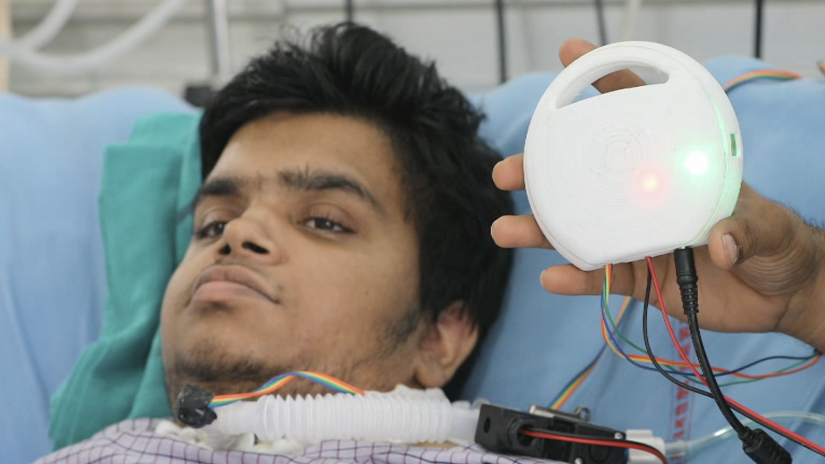
Sachin is been given oxygen support with the new portable ventilator
Dr Deepak Agrawal, professor, neurosurgery at All India Institute of Medical Sciences, Delhi is most happy when he sends his patients back home after successful treatment. But he was not really happy that he was not unable to treat and discharge 18-year-old Sachin, who had been in the neurology ward at AIIMS for the last 3 years. Sachin, was admitted after he suffered a cervical injury that left his all four limbs immobile. A few corrective surgeries at the hospital didn’t help him recover from the injury. His long stay at the hospital in Delhi cost his father his job and all the bank savings. His father spent most of the three years at AIIMS by his side.
But Sachin could have been taken care of at home if he had a ventilator. A year back, Dr Agrawal raised funds to buy him a ventilator but the family could not even bear the cost of oxygen that costs Rs 5000 per day.
He wanted to help Sachin and people like him, who cannot afford the high cost of a conventional ventilator. In a conference, Dr Agrawal met Diwakar Vaish, a young robotic engineer. He shared Sachin’s story with him and the duo decided to make an affordable ventilator for people like him.
The plan was quite ambitious. Dr Agrawal wanted this ventilator to be portable and easy to carry. A conventional ventilator is the size of an ATM machine. He also wanted it to have an app-based function so that it could transfer vital information to the treating doctor if needed.
It took Diwakar, who has many patents to his credit, six months to design the machine and another three months to make it functional. “It was amazing. Diwakar had converted the giant machine into a tablet size sleek device that can be carried in a pocket. My happiness knew no bounds when I saw it,” says Dr Agrawal.
This pocket sized ventilator is as accurate as any high-end conventional ventilator. It has two components—a tablet size ventilator, a valve that attaches to patient’s food pipe and drives the air in and an android phone . “Most interestingly, the ventilator doesn’t require any oxygen supply and works with the air present around us,” says Diwakar. “We have ensured that it takes air steadily, and in required quantity.”
Agrees Dr Aggarwal, “The concentration of oxygen we give to patients artificially is 40-45 percent. The air has 21 per cent oxygen in it. But any patient who has working lungs can easily process the atmosphere air. Patients with head injuries, cervical and spinal injuries, respiratory problems often need ventilator at home. This ventilator will help them all.”
Now Sachin, is all set to go home. His father can afford the new portable ventilator, which has one time cost of Rs 15,000.
Pocket-size ventilator at a glance:
It costs Rs 15,000-20,000. A conventional ventilator cost Rs 4-5 lakh.
It uses atmospheric air instead of oxygen cylinders
A conventional ventilator uses oxygen cylinders worth Rs 4 to 5 thousand everyday
It uses electricity and can work on battery backup
It is portable and thus will provide mobility to patients dependent on ventilator.